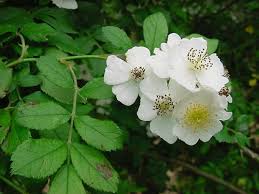### The History and Origin of Rosa laevigata

Rosa laevigata, commonly known as the Cherokee rose, is a species of rose native to southern China and Taiwan. It has been widely naturalized in the southeastern United States and is recognized for its distinctive white blossoms and glossy, evergreen leaves. The Cherokee rose is not only admired for its beauty but also holds significant cultural and historical importance. This article delves into the rich history and origin of Rosa laevigata, exploring its botanical characteristics, cultural significance, and journey across continents.
#### Botanical Characteristics
Rosa laevigata is a member of the Rosaceae family and is characterized by its vigorous growth and climbing habit. It is a deciduous or semi-evergreen shrub that can reach heights of 3 to 6 meters, often sprawling over other vegetation. The leaves are dark green, leathery, and compound with three leaflets. Each leaflet is ovate and finely serrated, providing a lush backdrop to the plant’s stunning flowers.
The flowers of Rosa laevigata are large, single, and typically measure 6 to 10 centimeters in diameter. They have five petals, which are pure white with a cluster of yellow stamens at the center. The flowers are fragrant, adding to their appeal. Blooming in early spring, the Cherokee rose brings a burst of color and scent to gardens and natural landscapes.
#### Historical Background
The history of Rosa laevigata is as enchanting as its blossoms. Native to southern China and Taiwan, this rose species has been cultivated for centuries. In its native regions, it is often found growing in the wild along hillsides, forests, and roadsides. The plant’s hardiness and adaptability have contributed to its widespread distribution.
The introduction of Rosa laevigata to the United States is a tale interwoven with cultural exchange and historical events. It is believed that the Cherokee rose was brought to North America by early European settlers. However, the most compelling narrative involves its association with the Cherokee people. According to legend, the Cherokee rose became a symbol of the Cherokee Nation during the Trail of Tears, a tragic period in the 1830s when the Cherokee were forcibly removed from their ancestral lands.
#### Cultural Significance
The Cherokee rose holds a special place in the hearts of the Cherokee people. The flower’s white petals symbolize the tears shed by Cherokee women during the Trail of Tears, while the gold center represents the gold taken from their lands. The plant’s ability to thrive and spread in the harshest conditions is seen as a symbol of the Cherokee people’s resilience and strength.
In addition to its significance to the Cherokee Nation, Rosa laevigata is celebrated in various cultures for its beauty and medicinal properties. In traditional Chinese medicine, the roots of Rosa laevigata have been used to treat conditions such as inflammation and dysentery. The plant’s hardy nature and medicinal uses have made it a valuable resource in different parts of the world.
#### Introduction to the Southeastern United States
The naturalization of Rosa laevigata in the southeastern United States is a testament to the plant’s adaptability and resilience. The Cherokee rose thrives in the warm, humid climate of the region and has become a common sight in states like Georgia, Alabama, and Florida. Its vigorous growth and climbing habit allow it to spread rapidly, often forming dense thickets.
The introduction of Rosa laevigata to the southeastern United States is attributed to European settlers who valued the plant for its ornamental and practical uses. The rose’s ability to form impenetrable thickets made it useful for creating natural barriers and hedges. Additionally, the plant’s beauty and fragrance made it a popular choice for gardens and landscapes.
#### Botanical Exploration and Classification
The classification of Rosa laevigata has been a subject of interest for botanists and horticulturists. The plant was first formally described by the Swedish botanist Carl Peter Thunberg in 1784. Thunberg, who traveled extensively in Asia, encountered the rose in Japan and documented its unique characteristics. His work laid the foundation for further botanical exploration and study of the species.
In the 19th century, Rosa laevigata caught the attention of Western botanists and plant collectors. The plant’s introduction to Europe and North America led to increased interest and study. Botanists sought to understand the plant’s growth habits, reproductive mechanisms, and potential uses. The classification of Rosa laevigata within the broader Rosaceae family has been refined over the years, with modern taxonomy placing it firmly within the genus Rosa.
#### Adaptation and Spread
The adaptability of Rosa laevigata has enabled it to spread far beyond its native range. In the southeastern United States, the plant has become naturalized, thriving in the region’s warm climate. The rose’s ability to grow in a variety of soil types and its resistance to pests and diseases have contributed to its success.
The spread of Rosa laevigata is also facilitated by its reproductive strategies. The plant produces abundant seeds, which are dispersed by birds and other animals. Additionally, Rosa laevigata can propagate vegetatively through its runners, allowing it to form dense colonies. This combination of sexual and asexual reproduction ensures the plant’s continued spread and survival.
#### Conservation and Management
While Rosa laevigata is celebrated for its beauty and cultural significance, it is also considered an invasive species in some regions. The plant’s vigorous growth and ability to form dense thickets can outcompete native vegetation, leading to ecological imbalances. In areas where it is considered invasive, management strategies are employed to control its spread.
Conservation efforts focus on balancing the preservation of Rosa laevigata’s cultural and historical significance with the need to protect native ecosystems. In regions where the plant poses a threat to biodiversity, measures such as mechanical removal, controlled burning, and the use of herbicides are implemented to manage its growth.
Conclusion
The history and origin of Rosa laevigata, the Cherokee rose, are rich with cultural, botanical, and historical significance. From its native habitats in southern China and Taiwan to its naturalization in the southeastern United States, this resilient and beautiful plant has left an indelible mark on the landscapes and cultures it has touched. Its association with the Cherokee people and its symbolic representation of strength and resilience add layers of meaning to its story. As we continue to study and appreciate Rosa laevigata, we honor not only the plant itself but also the histories and cultures it represents.
### The History and Origin of Rosa laevigata (Part 2)
#### Medicinal Uses and Traditional Applications
Rosa laevigata, known for its resilience and beauty, also boasts a history rich with medicinal uses. In traditional Chinese medicine, the roots, leaves, and flowers of Rosa laevigata have been utilized for their therapeutic properties. The plant is known to have anti-inflammatory, astringent, and diuretic effects, making it valuable in treating a variety of ailments.
**Roots and Leaves:**
The roots of Rosa laevigata have been traditionally used to treat conditions such as diarrhea and dysentery. They are believed to strengthen the immune system and improve overall health. The leaves, when brewed into a tea, have been used to alleviate sore throats and reduce fevers. Additionally, the leaves possess astringent properties that help in the healing of wounds and reduction of skin inflammation.
**Flowers:**
The flowers of Rosa laevigata are not only admired for their beauty but also for their soothing properties. The petals can be infused to create a fragrant tea that is said to calm the nerves and promote relaxation. Moreover, the flowers have been used in the preparation of herbal remedies aimed at improving digestive health and treating respiratory issues.
#### Symbolism and Mythology
The symbolism of Rosa laevigata extends beyond its medicinal uses, embedding itself in the mythology and folklore of the cultures it has touched. The Cherokee rose, in particular, carries deep symbolic meanings.
**The Cherokee Legend:**
As previously mentioned, the Cherokee rose is associated with the Trail of Tears, the forced relocation of the Cherokee Nation in the 1830s. The legend states that the mothers of the Cherokee Nation cried so much during the journey that the Great Spirit took pity on them and transformed their tears into the Cherokee rose. The white petals symbolize the tears, while the golden center represents the gold taken from their lands. This poignant story underscores the plant’s role as a symbol of resilience and hope in the face of adversity.
**Cultural Symbolism:**
Beyond the Cherokee legend, the Cherokee rose has been adopted as a symbol of the state of Georgia, where it was designated the state floral emblem in 1916. The flower represents the strength and tenacity of the people, mirroring the plant’s ability to thrive in challenging conditions. Its enduring presence in gardens and wild landscapes across the southeastern United States continues to inspire and remind people of the region’s rich history.
#### Horticultural Practices
Cultivating Rosa laevigata requires an understanding of its growth habits and environmental preferences. Gardeners and horticulturists have long appreciated this rose for its low maintenance and robust nature.
**Growing Conditions:**
Rosa laevigata thrives in a variety of soil types but prefers well-drained, fertile soil. It is well-suited to both full sun and partial shade, although full sun promotes the best flowering. The plant is drought-tolerant once established, making it an excellent choice for gardens in regions with dry spells.
**Propagation:**
Propagation of Rosa laevigata can be achieved through seeds or cuttings. Seed propagation involves collecting the rose hips, extracting the seeds, and planting them in a suitable medium. However, this method can be slow and requires patience. Alternatively, propagation through cuttings is more common and reliable. Hardwood or semi-hardwood cuttings taken in late summer or early autumn root readily when placed in a moist, well-draining medium.
**Pruning and Maintenance:**
Pruning is essential for maintaining the health and appearance of Rosa laevigata. Regular pruning helps control its vigorous growth, encourages flowering, and removes any dead or diseased wood. The best time to prune is in late winter or early spring before new growth begins. Gardeners should aim to create an open structure to allow light and air to penetrate the plant, reducing the risk of disease.
#### Ecological Impact and Invasive Potential
While Rosa laevigata is cherished for its beauty and cultural significance, it is important to recognize its potential as an invasive species. In some regions, the plant’s aggressive growth can pose a threat to native ecosystems.
**Invasive Characteristics:**
The vigorous growth habit of Rosa laevigata allows it to quickly dominate landscapes, outcompeting native plants for resources such as light, water, and nutrients. Its ability to form dense thickets can lead to a reduction in biodiversity, altering habitats and displacing native flora and fauna.
**Management Strategies:**
Managing the spread of Rosa laevigata in areas where it is considered invasive requires a multifaceted approach. Mechanical control methods, such as cutting and mowing, can be effective but often need to be repeated regularly. Chemical control, involving the use of herbicides, may be necessary for large infestations. Additionally, biological control methods, such as introducing natural predators or pathogens, are being explored as sustainable solutions.
**Balancing Conservation and Control:**
Efforts to manage Rosa laevigata must balance the need to protect native ecosystems with the desire to preserve the cultural and historical significance of the plant. Public education and awareness campaigns can help inform communities about the potential impacts of planting and spreading invasive species. Encouraging the use of native or non-invasive ornamental plants in gardens and landscaping projects is also crucial.
#### Modern Applications and Research
In contemporary times, Rosa laevigata continues to be a subject of interest for researchers and horticulturists. Its potential applications extend beyond traditional uses, with ongoing studies exploring new ways to utilize the plant.
**Pharmaceutical Research:**
Modern pharmaceutical research is investigating the bioactive compounds found in Rosa laevigata. Studies have identified various compounds with antioxidant, antimicrobial, and anti-inflammatory properties. These findings have the potential to lead to the development of new drugs and treatments derived from the plant.
**Genetic Studies:**
Advances in genetic research are providing new insights into the characteristics and adaptability of Rosa laevigata. Understanding the genetic makeup of the plant can help in the development of new cultivars with enhanced traits, such as improved disease resistance or greater tolerance to environmental stressors.
**Horticultural Innovations:**
Horticulturists are continually experimenting with new cultivation techniques and hybridization efforts to enhance the ornamental value of Rosa laevigata. These innovations aim to create new varieties with diverse flower colors, extended blooming periods, and compact growth habits suitable for urban gardens.
#### Conclusion
Rosa laevigata, the Cherokee rose, is a plant with a multifaceted history and enduring significance. From its origins in southern China and Taiwan to its cultural symbolism with the Cherokee people and its naturalization in the southeastern United States, the journey of this rose is a testament to its resilience and adaptability. Its medicinal uses, cultural symbolism, and horticultural value continue to captivate and inspire. As we look to the future, ongoing research and conservation efforts will ensure that Rosa laevigata remains a cherished and respected part of our natural and cultural heritage.

